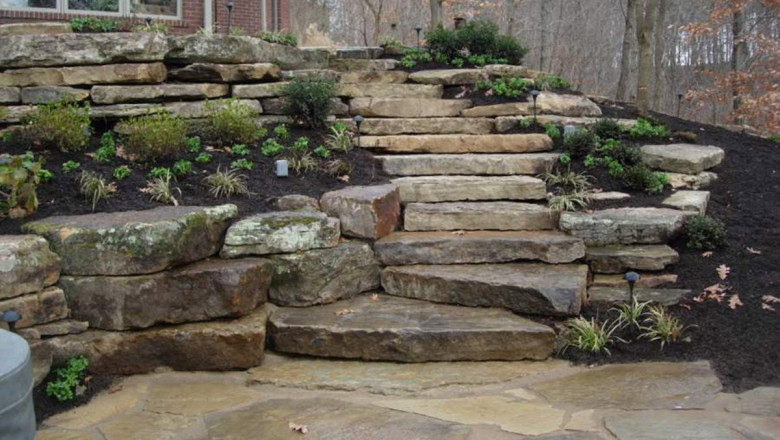views
Adding steps to an outdoor space isn’t just about function—it’s also an opportunity to introduce timeless character. Whether you're working on a garden path, a sloped entrance, or connecting different elevations in your yard, sandstone steps offer a natural, durable, and visually appealing solution.
In this guide, we’ll explore what makes sandstone such a great material for outdoor steps, how it pairs with sandstone blocks, and why choosing the right sandstone suppliers—like Maroota Sandstone Quarry—can make all the difference.
Why Choose Sandstone for Outdoor Steps?
Sandstone has long been favored in outdoor construction due to its strength, natural texture, and warm tones. It holds up well against weather and wear, which makes it especially suited for heavily used areas like steps and walkways.
Unlike manufactured materials, sandstone offers unique variations in color and surface detail. These subtle differences give each step a distinct look, adding a layer of visual interest that’s hard to replicate.
Beyond its appearance, sandstone is practical. It offers good traction even when wet, especially if the stone is left with a rougher finish. That makes it a safe and smart choice for areas where slipping could be a conceIntegrating Sandstone Steps with the Landscape
One of the great advantages of sandstone steps is how easily they blend into natural and built environments. Whether you’re designing a formal entrance or a rustic garden trail, sandstone complements a wide range of styles.
For a more cohesive look, many homeowners and builders choose to pair their steps with sandstone blocks. These blocks can be used to build retaining walls, raised garden beds, or borders alongside the steps. When the color and texture of the stone are consistent, it brings a sense of unity to the whole space.
Products from Maroota Sandstone Quarry, for example, are known for their natural appearance and durability. Sourcing your steps and blocks from the same supplier ensures you get a harmonious look without mismatched tones or textures.
Choosing the Right Sandstone
Not all sandstone is the same. When selecting stone for steps or blocks, you’ll want to consider several factors:
-
Thickness and Size: Steps should be thick enough to handle weight without cracking. Standard step treads often range between 2 and 4 inches thick.
-
Finish: A sawn, split, or bush-hammered finish will affect both the appearance and traction. Rougher textures offer better grip.
-
Color Consistency: Sandstone comes in shades of cream, pink, brown, and gold. It’s helpful to view samples before ordering.
-
Durability: Ask your sandstone suppliers about the stone’s strength and weather resistance, especially if you live in an area with freeze-thaw cycles.
Installation Tips for Sandstone Steps
Installing sandstone steps requires careful planning and preparation. Here are a few basic pointers:
-
Foundation Matters: Start with a stable, level base—usually compacted road base or concrete—for proper support.
-
Allow for Drainage: Make sure water can drain away from the steps to prevent erosion and reduce slipping.
-
Use Consistent Risers and Treads: For safety and comfort, keep the height and depth of each step as uniform as possible.
-
Consider Edge Finishes: A rounded or chiseled edge can soften the appearance and reduce sharp corners.
If you’re unsure about installation, working with an experienced mason or landscaper can help avoid costly mistakes.
Final Thoughts
Sandstone steps are more than just a way to move between levels—they’re an investment in both beauty and durability. When chosen carefully and installed correctly, they can transform outdoor areas into inviting, functional spaces.
Pairing them with sandstone blocks and sourcing them from trusted sandstone suppliers like Maroota Sandstone Quarry ensures consistency, quality, and a finished result that feels timeless.
FAQs About Sandstone Steps
Q: Are sandstone steps slippery when wet?
A: Sandstone has a naturally textured surface that offers decent grip. Choosing a rough finish—like split or bush-hammered—can make it even more slip-resistant.
Q: How do I maintain sandstone steps?
A: Regular sweeping and occasional hosing down are usually enough. For stains, use a mild stone cleaner. Sealing is optional but can help protect against moisture and discoloration.
Q: Can sandstone be used in cold climates?
A: Yes, as long as it’s properly sealed and installed to allow for drainage. Quality sandstone, like what’s available from Maroota Sandstone Quarry, performs well even in freeze-thaw conditions.
Q: How long do sandstone steps last?
A: With proper installation and minimal care, sandstone steps can last for decades. The stone naturally weathers over time, which adds to its charm.














Comments
0 comment